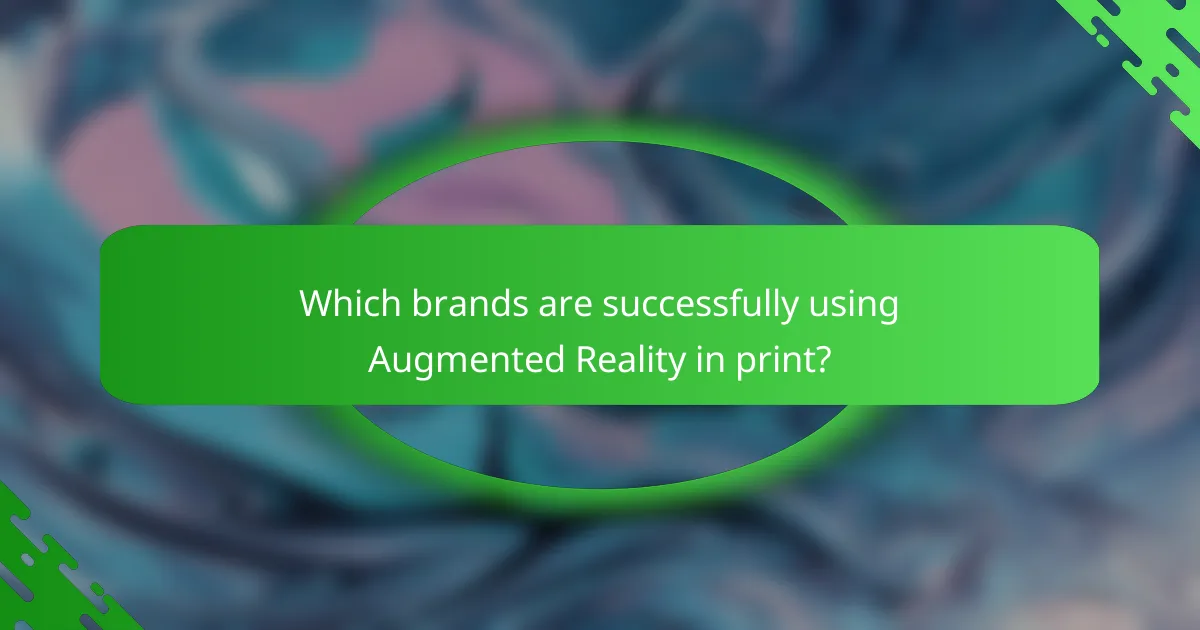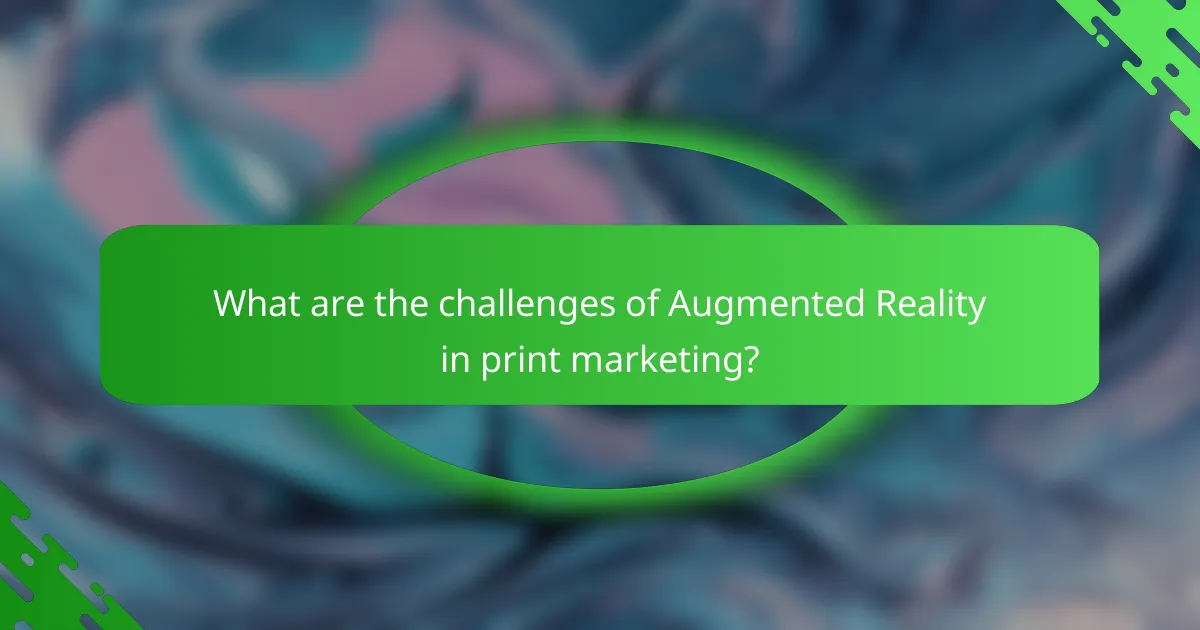Augmented Reality (AR) is transforming print marketing by merging digital content with physical materials, offering consumers immersive and interactive experiences. This innovative approach enables brands to deepen their connections with audiences, enhancing traditional marketing strategies and fostering greater consumer engagement.

How is Augmented Reality transforming print marketing?
Augmented Reality (AR) is revolutionizing print marketing by creating immersive experiences that engage consumers in new ways. By integrating digital content with physical print materials, brands can enhance their marketing strategies and foster deeper connections with their audience.
Enhanced consumer interaction
AR allows consumers to interact with print materials in a dynamic manner, turning static images into engaging experiences. For instance, a magazine ad might come to life with a 3D model or an animated video when scanned with a smartphone, encouraging users to explore the content further.
This level of interaction not only captivates attention but also encourages consumers to spend more time engaging with the brand, which can lead to higher retention rates and a stronger brand recall.
Increased brand engagement
By utilizing AR, brands can create memorable experiences that resonate with consumers. Interactive elements, such as games or quizzes embedded in print ads, can significantly boost engagement levels, making the marketing material more enjoyable and shareable.
For example, a restaurant could use AR to showcase its menu items in 3D, allowing customers to visualize their meals before ordering, thereby increasing interest and likelihood of purchase.
Real-time product information
AR can provide consumers with immediate access to detailed product information, enhancing their decision-making process. When a user scans a product label, they can view specifications, reviews, or even instructional videos, all in real-time.
This instant access to information can help consumers feel more informed and confident in their purchases, reducing the likelihood of buyer’s remorse and increasing overall satisfaction.
Personalized marketing experiences
With AR, brands can deliver tailored experiences based on consumer preferences and behaviors. By analyzing user interactions, companies can customize the content displayed through AR, making it more relevant and appealing to individual users.
For instance, a beauty brand might offer AR try-ons for different makeup products, allowing customers to see how various shades look on their skin tone, thus enhancing the shopping experience and driving conversions.

What are the benefits of using Augmented Reality in print?
Augmented Reality (AR) in print enhances traditional marketing by creating interactive experiences that engage consumers more effectively. This technology allows brands to connect with customers in innovative ways, leading to increased interest and interaction with printed materials.
Improved customer retention
Using AR in print can significantly boost customer retention by creating memorable experiences. When customers interact with AR features, they are more likely to remember the brand and return for future purchases. For instance, a magazine ad that allows users to scan and view a 3D product can leave a lasting impression.
To maximize retention, brands should ensure that AR content is relevant and provides value, such as exclusive offers or additional information. Engaging storytelling through AR can also enhance emotional connections with the brand.
Higher conversion rates
Augmented Reality can lead to higher conversion rates by making the purchasing process more engaging and informative. When customers can visualize products in their own environment or see them in action, they are more likely to make a purchase. For example, furniture retailers that offer AR apps enabling users to see how a piece fits in their home often report increased sales.
To effectively leverage AR for conversions, brands should integrate clear calls to action within the AR experience. Ensuring a seamless transition from the AR interaction to the purchase process is crucial for capturing sales.
Cost-effective marketing strategies
Implementing AR in print can be a cost-effective marketing strategy, especially when compared to traditional advertising methods. By utilizing existing print materials and enhancing them with AR, brands can create dynamic content without the need for extensive new campaigns. This approach can reduce overall marketing costs while increasing engagement.
Brands should consider using AR to repurpose existing content, such as brochures or flyers, rather than creating entirely new materials. This not only saves costs but also maximizes the return on investment by revitalizing current assets.

Which brands are successfully using Augmented Reality in print?
Several brands are effectively leveraging augmented reality (AR) in print to enhance consumer engagement and marketing strategies. Notable examples include IKEA, Pepsi, and National Geographic, each utilizing AR to create interactive experiences that captivate their audiences.
IKEA’s AR catalog
IKEA has transformed its traditional catalog into an interactive AR experience, allowing customers to visualize furniture in their own homes. By using the IKEA Place app, users can scan their surroundings and place 3D models of furniture items to see how they fit in their space.
This approach not only enhances customer experience but also reduces the likelihood of returns, as consumers can make more informed decisions. The AR catalog has proven to be a valuable tool for driving sales and increasing customer satisfaction.
Pepsi’s interactive ads
Pepsi has implemented AR in its advertising campaigns, creating interactive experiences that engage consumers in unique ways. For instance, their “Pepsi Max Unbelievable” campaign featured ads that came to life when scanned with a smartphone, showcasing entertaining animations and interactive content.
This strategy effectively captures attention and encourages sharing on social media, amplifying brand visibility. Brands considering similar approaches should focus on creating compelling narratives that resonate with their target audience.
National Geographic’s AR experiences
National Geographic has embraced AR to enhance its storytelling, offering readers immersive experiences that bring articles to life. Through their app, users can interact with wildlife and explore historical sites in 3D, deepening their understanding of the content.
This innovative use of AR not only enriches the reading experience but also fosters a stronger connection between the audience and the subject matter. Brands should consider how AR can complement their existing content to create memorable interactions.

How can businesses implement Augmented Reality in their print materials?
Businesses can implement Augmented Reality (AR) in their print materials by integrating interactive digital experiences that engage consumers and enhance their understanding of products. This involves selecting suitable AR platforms, designing compelling content, and aligning these efforts with existing marketing strategies.
Choosing the right AR platform
Selecting the appropriate AR platform is crucial for successful implementation. Businesses should consider factors such as ease of use, compatibility with various devices, and the ability to create customized experiences. Popular platforms like Zappar, Blippar, and Layar offer different features catering to various marketing needs.
Evaluate the costs associated with each platform, including subscription fees and any additional development expenses. A clear understanding of your target audience’s technology preferences can also guide your choice, ensuring that the AR experience is accessible to the majority of users.
Designing interactive content
Creating engaging interactive content is essential for capturing consumer interest. This can include 3D models, videos, or animations that provide additional product information or storytelling elements. Ensure that the content is visually appealing and relevant to the print material to maintain coherence.
Consider incorporating gamification elements, such as quizzes or rewards, to further engage users. Testing the content with a focus group can provide valuable feedback and help refine the experience before a wider launch.
Integrating with existing marketing strategies
To maximize the impact of AR in print materials, businesses should integrate these experiences with their overall marketing strategies. This includes promoting the AR features through social media, email campaigns, and in-store displays to drive consumer awareness and participation.
Align AR initiatives with broader marketing goals, such as brand awareness or customer retention. Regularly analyze engagement metrics to assess the effectiveness of the AR content and make adjustments as necessary to enhance performance and consumer satisfaction.

What technologies support Augmented Reality in print?
Augmented Reality (AR) in print is primarily supported by software solutions, mobile applications, and technologies like QR codes and image recognition. These elements work together to create interactive experiences that engage consumers and enhance marketing efforts.
AR software solutions
AR software solutions are essential for developing interactive content that can be integrated into print materials. These platforms allow marketers to create overlays that enhance the physical product with digital information, animations, or videos. Popular software options include Vuforia, Zappar, and Blippar, which offer user-friendly interfaces for designing AR experiences.
When selecting AR software, consider factors such as ease of use, compatibility with various devices, and the ability to track user engagement. A good solution should also support multiple types of content, from 3D models to video clips, to maximize consumer interaction.
Mobile applications
Mobile applications play a crucial role in delivering AR experiences to users. These apps typically use the camera and sensors of smartphones or tablets to recognize printed materials and trigger AR content. Brands can either develop their own dedicated apps or utilize existing platforms that support AR features.
For effective consumer engagement, ensure that the mobile application is intuitive and provides a seamless user experience. Consider integrating social sharing features to encourage users to share their AR experiences, which can amplify marketing reach.
QR codes and image recognition
QR codes and image recognition technologies are vital for bridging the gap between print and digital content. QR codes can be printed on marketing materials, allowing users to scan them with their mobile devices to access AR experiences instantly. Image recognition, on the other hand, enables the app to identify specific images or objects in print and display relevant AR content.
To optimize the use of QR codes, place them prominently and ensure they lead to engaging content. For image recognition, choose clear and distinct images that are easily recognizable by the AR software. This will enhance user interaction and improve the overall effectiveness of your AR marketing strategy.

What are the challenges of Augmented Reality in print marketing?
Augmented Reality (AR) in print marketing faces several challenges, including technical limitations, user experience issues, and integration with existing marketing strategies. These obstacles can hinder the effectiveness of AR campaigns and affect consumer engagement.
Technical limitations
Technical limitations in AR for print marketing often stem from device compatibility and software requirements. Many consumers may not have access to the latest smartphones or tablets that support advanced AR features, which can restrict audience reach.
Additionally, AR applications can require significant processing power and memory, leading to performance issues on older devices. Marketers should ensure their AR content is optimized for a wide range of devices to avoid frustrating users.
To mitigate these challenges, consider developing lightweight AR experiences that load quickly and function smoothly on various platforms. Testing your AR application on different devices before launch can help identify potential issues early on.



